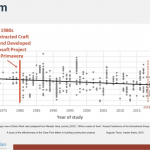(Hal Macomber, EVP, Touchplan with Carla Ciepliski, P.Eng. Owner & Consultant, Ternion Results Inc) – Collaboration has played a large role in the progress the industry made with Lean design and construction projects. It started in 1994 when the academic community began a collaboration that they called the International Group for Lean Construction (IGLC) to explore revolutionizing this industry. It continues with 27 years of double-blind peer-reviewed conference papers numbering in the thousands, often with multiple authors each. The Lean Construction Institute followed their example in creating opportunities at the local and national levels for people to learn, advance, and share their experiences with competitors and other stakeholders in the construction supply chain. In 2004, as the five big ideas took shape, “Really Collaborating” became the first organizing behavior.
This is the previous guidance for “Really Collaborate” from Putting the Five Big Ideas to Work:
Here are 5 questions to get you started to make collaboration your habit:
- Who could help me with this?
- What do I have to offer others?
- What new ways can we meet on a regular basis?
- How can we stay in tune with each others’ changing project work?
- What can you do to be more responsive to each other?
Bring this up to your team at your next meeting. Use the five questions to generate actions you will take as a group. Revisit how you are doing each time you meet.
After 10 more years of experience, we learned that it was much more than individual behavior. Collaboration is also about the design of interactions and the system within which people interact.
Collaboration as Action and Mood
Ultimately, ownership lies with each of us as individuals to choose our behaviors in every situation and considering each human interaction we participate in. These are some key observable behaviors that support collaboration:
- Demonstrating appreciation for the point of view of others
- Maintaining openness to be changed by what others say
- Focusing on the common team-oriented goal and being personally committed to achieving it
- Engaging effectively in productive conversations that balance advocacy and inquiry
- Show a personal balance in both supporting the task we are trying to complete together AND managing the relationship between ourselves and others
- Demonstrating trust-building behaviors in the small moments (thinking Brene Brown)
We also know that the pre-existing relationship between individuals is a dominant factor in the degree of success in collaboration. The additional effort individuals must apply in collaboration is directly related to the familiarity that individuals have with each other prior to the collaboration activity.
Processes and Structures Are Essential for Building Collaboration Competence
The greater the complexity and the greater the number of people involved … the greater or more robust the processes and structure will need to be in order to ensure collaboration effectiveness. While singing kumbaya and holding hands may work for creating a positive environment, it won’t help executing the task we need to complete in a productive or effective manner. After all, collaborating can also be defined as ‘Co-Laboring’, or accomplishing a task together. So, a key component to making “Really Collaborate” work is to leverage the appropriate team-based processes and techniques to create a structure to effectively navigate the collaboration activities. We know of no better micro-processes than Liberating Structures. These are innovative and small methods of improving our interactions with each other. We use them in our work to bring out the best in each other. You should too.
Use other supporting tools or processes depending on the activity your team is working on. For example, if your team is tasked with generating ideas to address a problem or challenge, you would benefit from some structured ideation techniques such as brainstorming, and brain walking. These techniques are intended to expose individual participant’s mental models visually, to allow for an improved understanding of the participant’s individual thoughts while creating a mechanism to build/expand/grow ideas collectively.
If your team is tasked with making a decision, you will benefit from a structured decision-making system such as Choosing By Advantages Decisionmaking. These sound methods produce alignment to the important factors associated with the decision and transparency for the basis of the decision. Regardless of what task your team is faced with doing, consider what additional structure is needed to help collaborative activity.
Develop the Habit for Collaborating with Others
Collaboration as a skill is always available when we have habituated the action. In other words, we are more successful when it’s an automatic action for us. Daniel Kahneman calls this system 1 thinking or fast thinking. It comes from practicing it purposefully with feedback on how we’re doing in the midst of action. The gold standard for developing that level of acting is deliberate practice. Anders Ericsson coined this term, and seriously studied and experimented with people to push their capabilities beyond what everyone thought was possible. (See The Making of an Expert and Peak: Secrets from the New Science of Expertise.) The rule of 10,000 hours of practice to become an expert’ came from his work. The good news is that you can become highly skilled with a small fraction of those hours just by using your everyday work as the setting for deliberately practicing collaboration.
If you missed last week’s installment please be sure to read Revisiting the Five Big Ideas. For more information on Lean Planning & Best Practice please read 4 Ways to Improve Projects Using Digital Tools. If you would like to learn about collaboration in action feel free to read our most recent case study Building A Partnership for Today and Beyond.
If you would like to revisit any of the posts from the Revisiting the Five Big Ideas series you can find all of them below.
- Part 1: Transforming the Design and Construction Industry
- Part 2: Collaborate; Really Collaborate
- Part 3: Tightly Couple Learning with Action
- Part 4: Optimize the Project as a Whole
- Part 5: Conduct Construction Projects as a Network of Commitments
- Part 6: Bring an Outward Mindset to All Interactions
- Part 7: Project Production Thinking Behind the Five Big
- Part 8: Pursue Project Outcomes at the Intersection of the Five Big Ideas
- Part 9: Adopting the Five Big Ideas on Your CM/GC Projects
- Part 10: What Comes After The Five Big Ideas?
Touchplan’s Master Schedule Alignment feature is a great collaboration tool. Learn more from our webinar.










